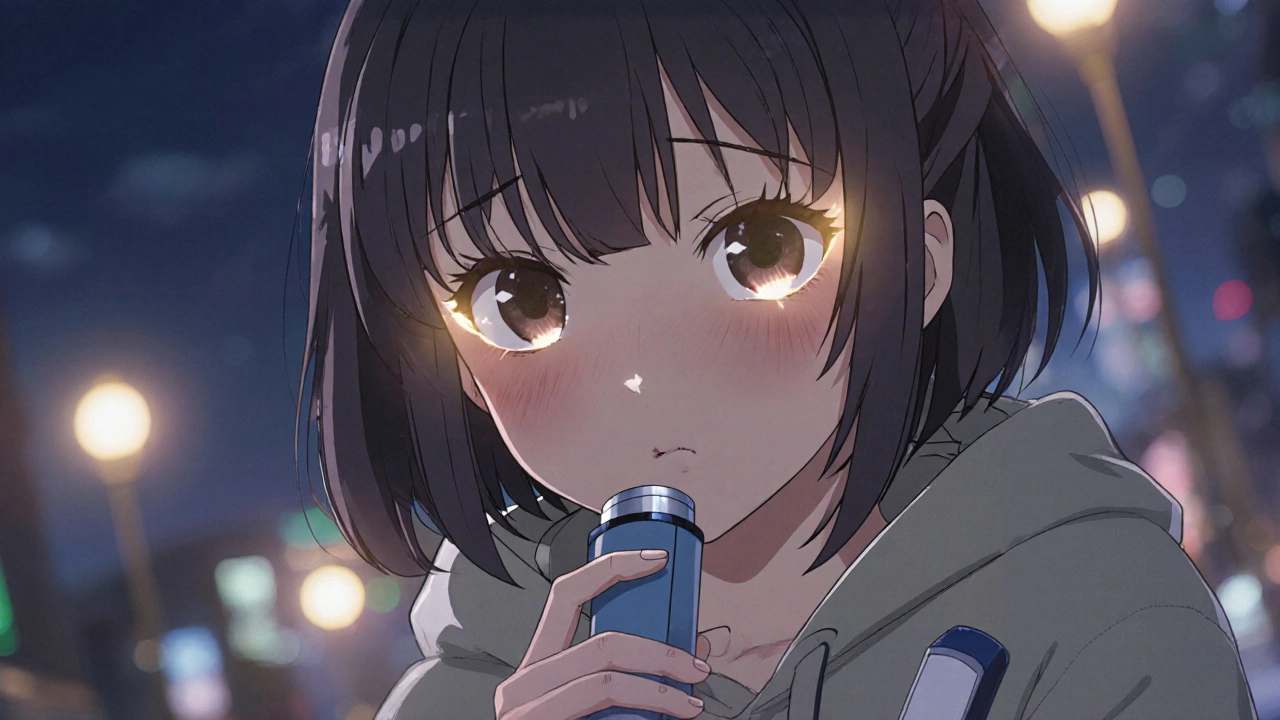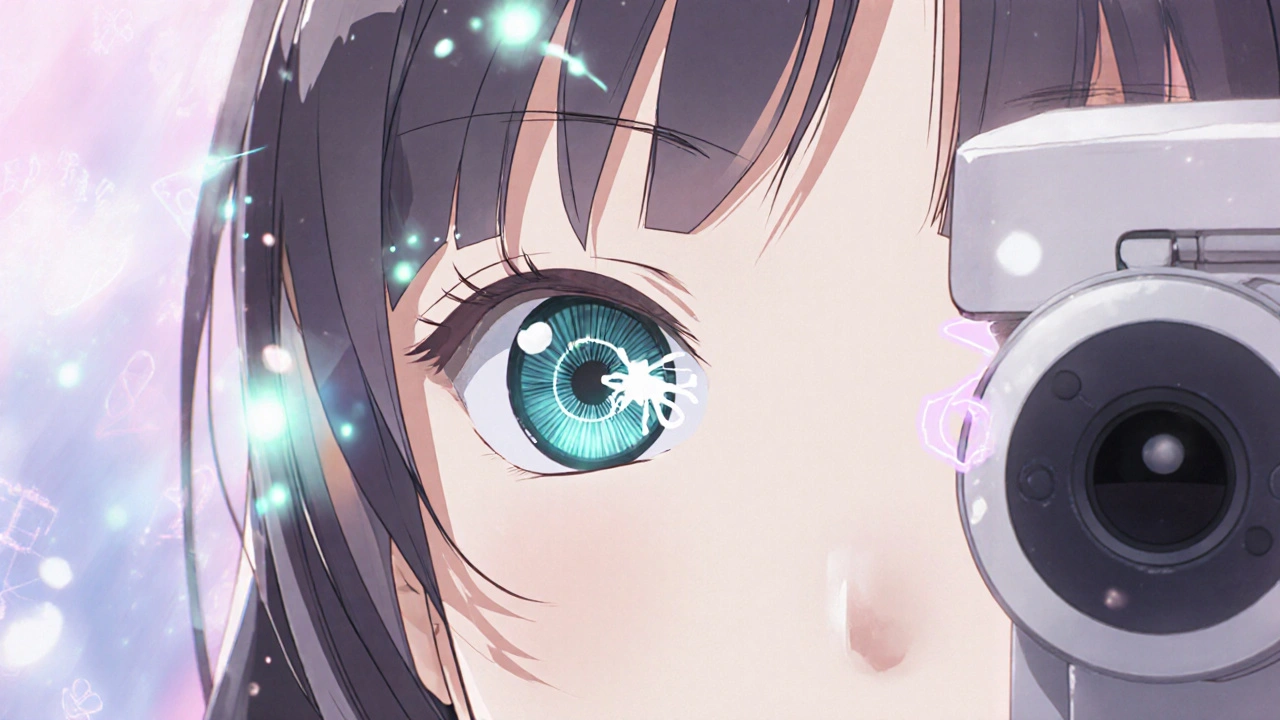
Steroid Cataract Risk Calculator
Assess Your Risk
Enter your steroid usage details below to get a personalized risk assessment. Early detection is key for preventing vision loss.
Your Risk Assessment
What Are Steroid-Induced Cataracts?
Steroid-induced cataracts are a type of lens clouding caused by long-term use of corticosteroids - drugs commonly prescribed for asthma, rheumatoid arthritis, eczema, and other inflammatory conditions. Unlike age-related cataracts that take years to develop, these can show up in as little as 2 to 4 weeks after starting steroid treatment. They’re not a side effect you can ignore. They directly interfere with how light enters your eye, and if left unchecked, they can make driving at night, reading, or even recognizing faces difficult.
The most common form is called a posterior subcapsular cataract (PSC). This isn’t a haze that spreads evenly across the lens. It forms a small, dense spot right at the back of the lens, directly in the path of incoming light. Even a tiny opacity here can cause major vision problems because it blocks light before it reaches the retina. This is why someone with a small PSC might struggle to read a book or see streetlights clearly at night, while someone with a much larger age-related cataract might still see okay in daylight.
How Steroids Actually Damage the Lens
It’s not just that steroids make your lens cloudy - they change the chemistry inside it. The lens is made mostly of proteins that need to stay perfectly arranged to keep light passing through cleanly. Corticosteroids interfere with this by forming abnormal chemical bonds with those proteins. Specifically, the C-20 ketone group in steroids reacts with amino acids in lens proteins, creating what’s called a Schiff base intermediate. This then rearranges into stable, non-reversible adducts that clump together. These clumps scatter light like tiny shards of glass inside your eye.
On top of that, steroids reduce the lens’s natural defenses. The lens doesn’t have blood vessels, so it relies on its own antioxidant systems to neutralize damaging free radicals. Steroids lower the levels of glutathione and other protective molecules, leaving the lens more vulnerable. Over time, this oxidative stress builds up, and the protein damage becomes permanent. Once those clumps form, they don’t go away on their own. That’s why stopping steroids doesn’t reverse the cataract - it only stops it from getting worse.
What You’ll Notice First: The Symptoms
If you’re on long-term steroids and your vision is changing, here’s what to watch for:
- Blurry vision - especially when reading or doing close work - reported in over 90% of cases.
- Glare and halos - headlights, streetlights, or even bright lamps look like they’re surrounded by a foggy ring. This is the most disruptive symptom for night driving.
- Faded colors - reds look dull, whites look grayish. It’s not just dimmer light; the color itself seems washed out.
- Double vision - not from misaligned eyes, but because the cloudy spot on the lens splits the light path.
- Difficulty seeing at night - 76% of patients report this as a major issue, even if daytime vision seems fine.
- Reduced peripheral vision - not a complete blind spot, but a sense that things at the edges of your view are less sharp.
These symptoms don’t come on slowly like typical aging cataracts. They often appear suddenly - one month you’re reading fine, the next you’re holding books farther away. That’s because PSCs grow quickly in the center of the visual field. If you’ve been on steroids for more than four months and notice any of these, don’t wait. Get your eyes checked.

Who’s at Highest Risk?
Not everyone on steroids gets cataracts - but some groups are far more vulnerable:
- People using topical eye drops - yes, even steroid eye drops. A 2024 study found these carry a 3.2 times higher risk than oral or inhaled steroids, even though people assume they’re safer because they’re applied locally.
- Those on high doses - taking more than 2,000mg of beclomethasone (a common inhaled steroid) or equivalent over time sharply increases risk.
- Patients on treatment longer than 4 months - the risk jumps significantly after this point, and continues rising with each additional month.
- Children - their lenses are more sensitive. Long-term steroid use in kids for asthma or eczema is linked to early cataract formation and elevated eye pressure.
- People with diabetes or uveitis - these conditions already stress the eye. Adding steroids multiplies the risk.
Even if you’re not in one of these groups, don’t assume you’re safe. Steroid-induced cataracts can happen to anyone who uses these drugs long enough. The key is awareness - not fear.
Can You Prevent Them?
There’s no magic pill or supplement proven to stop steroid-induced cataracts. Antioxidants like vitamin C or lutein have been studied, but no clinical guidelines support them as reliable prevention. The only proven strategy is minimizing exposure.
Ask your doctor: Can I use the lowest effective dose? Can I switch to a non-steroid alternative? For example, in asthma, newer biologics can replace long-term oral steroids. For skin conditions, topical calcineurin inhibitors like tacrolimus may be an option. If steroids are necessary, make sure your ophthalmologist knows you’re taking them - and when.
Baseline eye exams before starting steroids are critical. After that, get checked every 6 months if you’re on long-term treatment. Some clinics recommend every 3-4 months for high-risk patients. Early detection means you can plan ahead. If your cataract is still small, you can time surgery for when it’s most convenient - not when you’re already struggling to see.

What’s the Treatment?
There’s no eye drop, no laser, no pill that can clear a steroid-induced cataract. The only effective treatment is surgery.
Cataract surgery removes your cloudy natural lens and replaces it with a clear artificial one called an intraocular lens (IOL). It’s one of the most common and safest surgeries in the world. For steroid-induced cataracts, outcomes are excellent - 92% of patients report major vision improvement after surgery.
But here’s the catch: if you still need steroids after surgery, your new lens isn’t immune. You’ll need ongoing monitoring. Steroids can still cause swelling, increased eye pressure, or even inflammation around the new lens. Your surgeon will work with your primary doctor to manage this balance. Sometimes, they’ll delay surgery until steroid use can be reduced. Other times, they’ll proceed anyway and plan for extra follow-ups.
Don’t let fear of surgery hold you back. The vision loss from untreated cataracts is irreversible. Surgery restores function. Many patients say they didn’t realize how much they’d been missing - the color of their grandchild’s shirt, the clarity of street signs at night, the ease of reading labels.
Why This Matters More Than You Think
Over 24 million Americans have cataracts. About 10-15% of those cases are steroid-related - that’s 380,000 to 570,000 people every year in the U.S. alone. Globally, corticosteroid use is rising. More people are using them for autoimmune diseases, chronic lung conditions, and even severe allergies. As the population ages and steroid prescriptions increase, so will these cataracts.
And yet, awareness is low. A 2024 study found only 38.6% of people knew inhaled steroids could cause cataracts. Even among those who knew, many didn’t connect their vision changes to their medication. That’s dangerous. Vision loss isn’t just inconvenient - it increases fall risk, reduces independence, and worsens mental health.
It’s not about avoiding steroids. For many, they’re life-saving. But it’s about knowing the risk, watching for signs, and getting regular eye checks. A simple 10-minute exam with a slit-lamp can catch a cataract before it steals your sight.
What You Should Do Now
If you’re on steroids - whether it’s a nasal spray, inhaler, pill, cream, or eye drops - here’s your action plan:
- Check your usage - How long have you been on it? What’s the dose? Is it daily? If it’s been over 4 months, schedule an eye exam.
- Ask your doctor - "Could this medication be affecting my eyes?" and "Is there a lower-dose or non-steroid option?" Don’t stop taking it - just ask.
- Book an eye exam - Tell the optometrist or ophthalmologist you’re on steroids. They’ll use a slit-lamp to look for early posterior subcapsular changes. This is quick, painless, and often covered by insurance.
- Watch for symptoms - If you notice glare, faded colors, or blurry near vision, don’t wait. Get checked now.
- Keep records - Write down every steroid you’ve used, including brand names, doses, and dates. Bring this to every eye appointment.
Steroid-induced cataracts are preventable - not by avoiding treatment, but by staying informed. Your vision is worth protecting. A simple exam today could mean clear sight for years to come.





Comments (10)
Ardith Franklin
So let me get this straight... steroids cause cataracts in weeks, but the FDA still lets pharma companies market them like they're vitamin gummies? And nobody's suing? This is why I don't trust 'safe' meds. I bet they're hiding the real stats. I know someone who went blind on prednisone and got told to 'just wait it out'. Like, what even is this system?
Jenny Kohinski
This was so helpful 😊 I’ve been on inhaled steroids for asthma for 5 years and never knew about the eye risk. I’m booking an eye exam this week. Thank you for explaining it so clearly - I feel less scared now and more empowered. 💕
Aneesh M Joseph
Cataracts from steroids? Bro that’s just because people don’t blink enough. I’ve been on prednisone for 3 years and my vision’s fine. You just gotta toughen up. Also, eye exams are a scam. I’ve never needed one.
Deon Mangan
You know what’s funny? People panic about steroid cataracts like it’s some secret conspiracy. Nah. It’s just biology. Your lens is basically a protein soufflé. Pour steroids on it? It collapses. Simple. And yes, surgery works. 92%? That’s better than your iPhone’s battery life. Just don’t be lazy - get checked. And stop Googling ‘natural cataract cures’ - they’re all snake oil. 🤓
Vinicha Yustisie Rani
In my country, many people use steroid creams for skin allergies without knowing this risk. We think if it’s applied on skin, it can’t hurt the eyes. But the body absorbs. The eyes are delicate. I have seen old women with cataracts and they never connected it to the cream they used for eczema for years. Awareness is the first medicine.
Carlo Sprouse
Let’s be clear: if you’re on steroids long-term and haven’t had a retinal exam, you’re not just negligent - you’re statistically irresponsible. The data is published, peer-reviewed, and accessible. Ignorance isn’t a defense. This isn’t a suggestion. It’s a medical imperative. Stop treating your eyes like an afterthought.
Carl Lyday
I’m a nurse who’s seen this firsthand. A 12-year-old with severe eczema on topical steroids for 8 months - started having trouble seeing the board in school. Slit-lamp showed PSC like a bullet hole in the lens. Kid didn’t even know his vision was bad until he couldn’t read his own homework. Surgery fixed it. He’s back to baseball. The scary part? His mom had no clue steroids could do this. We need better patient handouts. This post? Perfect. Share it.
Tom Hansen
I’ve been on prednisone for 6 years and my vision is fine so this is probably just hype. Also who even reads the fine print anymore? Like come on. Eye exams are expensive and boring. I’d rather just squint.
Donna Hinkson
Thank you for writing this. I’ve been on inhaled steroids for COPD and never thought to mention it to my optometrist. I’ve been having trouble with headlights at night - thought it was just aging. I’ll schedule the exam this week. I appreciate you not just scaring people, but giving clear steps. That means a lot.
Rachel M. Repass
This is exactly the kind of post that bridges clinical science and lived experience. The Schiff base adduct formation? That’s not just jargon - it’s the molecular fingerprint of iatrogenic harm. And the fact that 76% report night vision loss? That’s not a symptom. That’s a societal blind spot. We need mandatory patient education packets with every steroid Rx - not just a pamphlet tucked in the bag. And yes, biologics are the future. But until then? Slit-lamp every 6 months. Non-negotiable. Your vision isn’t a luxury. It’s your primary interface with the world. Protect it like your life depends on it - because it does. 🌟